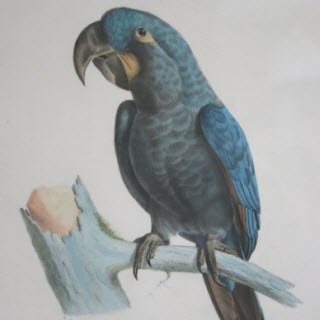Project Regions:
Glaucous Macaw |
|
|

Illustration © Bourjot Saint-Hilaire
Project Status: Completed | 1999
Collaborators/Funders
Biobrasil and Sheikh Saoud Bin Mohammed Bin Ali Al Thani
Blue macaw may be lost forever
The Glaucous Macaw (Anodorhynchus glaucus) has not been reliably recorded since the 1960s.
Project progress: In 1999 the World Parrot Trust sent Dr. Charles Munn, Carlos Yamashita, Richard Hartley and Alfredo Begazo to carry out a survey of the historical territory of the Glaucous Macaw (Anodorhynchus glaucus) in Brazil. The search found no birds in any of the areas surveyed.
Outcome: As well as confirming the loss of the Glaucous, the census was invaluable in producing expert and original information from Ph.D. ornithologists. This information on habitat loss, trapping for the pet trade, and other issues, will assist the conservation of species such as Lears, Spix's, Blue-throated and other macaws.
Wild population: Likely none
Where found: Formerly confined to regions in middle reaches of Rio Paraguay, Rio Parana and Rio Uruguay, in SE Paraguay, NE Argentina, in Corrientes and possibly Misiones, and Rio Grande do Sul, SE Brazil; possibly also Artigas, NW Uruguay.
History: Anodorhynchus glaucus was formerly widespread in N Argentina, S Paraguay, NE Uruguay and Brazil from Paraná state southwards. It was native to the areas around the major rivers (Uruguay, Paraná and Paraguay), with most records coming from Corrientes, Argentina. It was already rare in the second half of the 19th century, with only two acceptable sightings in the 20th century, including one direct observation in Uruguay in 1951 and one based on local reports. This species has been generally treated as extinct, however a few locals have reported sightings recently.
Threats:
This species' population likely declined rapidly due to human settlement of the major river basins within its range. It was possibly hunted and taken for the bird trade because it was conspicuous, both in size and colour. There is some evidence that it was trapped, but little to support various claims that there has been recent trade.
Ecology: The Glaucous Macaw was originally found in Paraguay, Argentina and Brazil. It was seen in subtropical gallery forests with cliffs and lightly wooded palm-rich savannas, where it would feed on the nuts of Butia yatay palms. It was a bird that was likely gregarious, nesting in steep banks or cliffs, or less often, tree cavities.
































